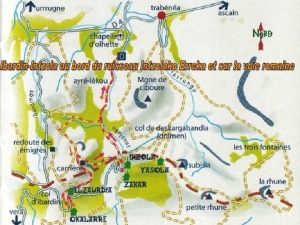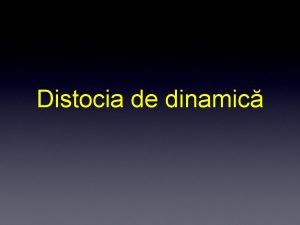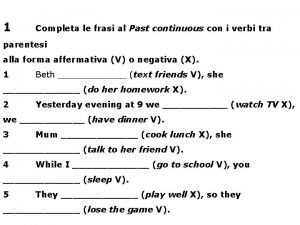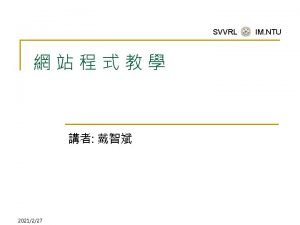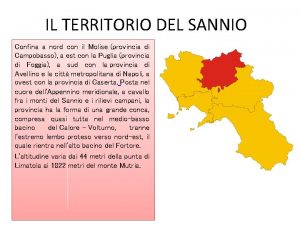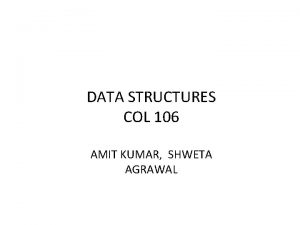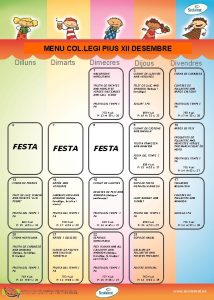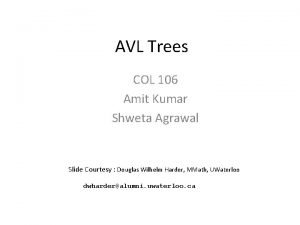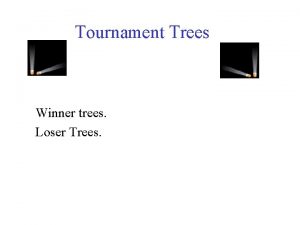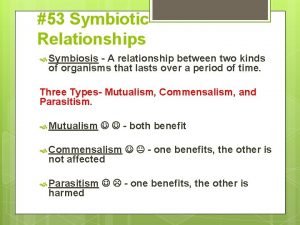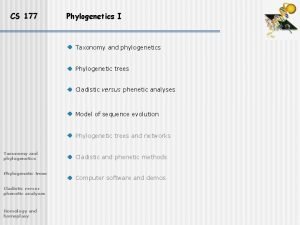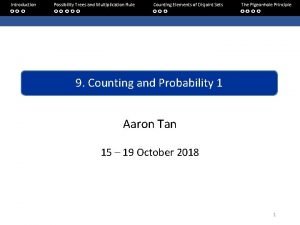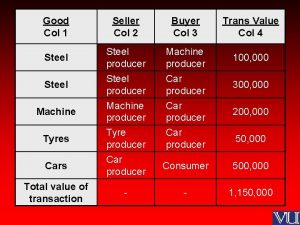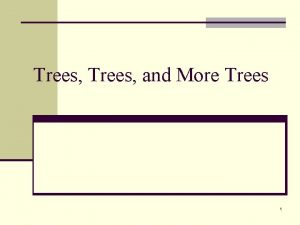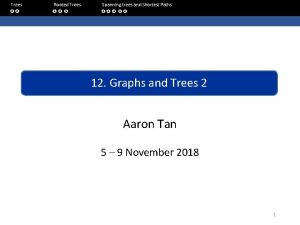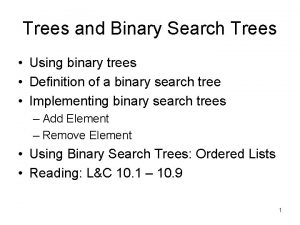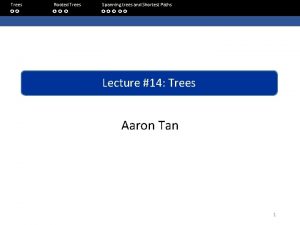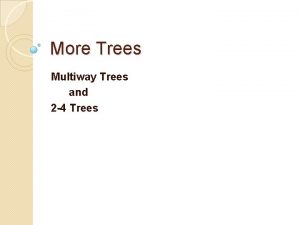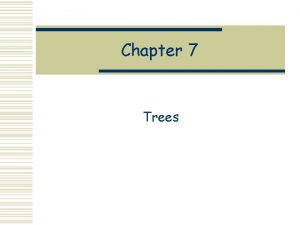2 3 and 2 3 4 Trees COL































































- Slides: 63

2 -3 and 2 -3 -4 Trees COL 106 Shweta Agrawal, Amit Kumar

Multi-Way Trees • A binary search tree: – One value in each node – At most 2 children • An M-way search tree: – Between 1 to (M-1) values in each node – At most M children per node

M-way Search Tree Details Each internal node of an M-way search has: – Between 1 and M children – Up to M-1 keys k 1 , k 2 , . . . , k. M-1 k 1 . . . ki-1 ki . . . k. M-1 Keys are ordered such that: k 1 < k 2 <. . . < k. M-1

Properties of M-way Search Tree k 1. . . T 1 . . . k i. . . k M-1 k i-1 Ti . . . TM • For a subtree Ti that is the i-th child of a node: all keys in Ti must be between keys ki-1 and ki i. e. ki-1 < keys(Ti )< ki • All keys in first subtree T 1, keys(T 1 )< k 1 • All keys in last subtree TM, keys(TM ) > k. M-1

Example: 3 -way search tree 68 Try: search 68

Search for X At a node consisting of values V 1. . . Vk, there are four possible cases: – If X < V 1, recursively search for X in the subtree that is left of V 1 – If X > Vk, recursively search for X in the subtree that is right of Vk – If X=Vi, for some i, then we are done (X has been found) – Else, for some i, Vi < X < Vi+1. In this case recursively search for X in the subtree that is between Vi and Vi+1 • Time Complexity: O((M-1)*h)=O(h) [M is a constant]

Insert X The algorithm for binary search tree can be generalized • Follow the search path – Add new key into the last leaf, or – add a new leaf if the last leaf is fully occupied Example: Add 52, 69 52 69

Delete X The algorithm for binary search tree can be generalized: • A leaf node can be easily deleted • An internal node is replaced by its successor and the successor is deleted Example: • Delete 10, Delete 44, Time complexity: O(Mh)=O(h), but h can be O(n)

M-way Search Tree What we know so far: • What is an M-way search tree • How to implement Search, Insert, and Delete • The time complexity of each of these operations is: O(Mh)=O(h) The problem (as usual): h can be O(n). • B-tree: balanced M-way Search Tree

2 -3 Tree

Why care about advanced implementations? Same entries, different insertion sequence: Not good! Would like to keep tree balanced.

2 -3 Trees Features Ø each internal node has either 2 or 3 children Ø all leaves are at the same level

2 -3 Trees with Ordered Nodes 2 -node • leaf node can be either a 2 -node or a 3 -node

Example of 2 -3 Tree

What did we gain? What is the time efficiency of searching for an item?

Gain: Ease of Keeping the Tree Balanced Binary Search Tree both trees after inserting items 39, 38, . . . 32 2 -3 Tree

Inserting Items Insert 39

Inserting Items Insert 38 insert in leaf divide leaf and move middle value up to parent result

Inserting Items Insert 37

Inserting Items Insert 36 divide leaf and move middle value up to parent insert in leaf overcrowded node

Inserting Items. . . still inserting 36 divide overcrowded node, move middle value up to parent, attach children to smallest and largest result

Inserting Items After Insertion of 35, 34, 33

Inserting so far

Inserting so far

Inserting Items How do we insert 32?

Inserting Items creating a new root if necessary tree grows at the root

Inserting Items Final Result

Deleting Items Delete 70 70 80

Deleting Items Deleting 70: swap 70 with inorder successor (80)

Deleting Items Deleting 70: . . . get rid of 70

Deleting Items Result

Deleting Items Delete 100

Deleting Items Deleting 100

Deleting Items Result

Deleting Items Delete 80

Deleting Items Deleting 80. . .

Deleting Items Deleting 80. . .

Deleting Items Deleting 80. . .

Deleting Items Final Result comparison with binary search tree

Deletion Algorithm I Deleting item I: 1. Locate node n, which contains item I 2. If node n is not a leaf swap I with inorder successor deletion always begins at a leaf 3. If leaf node n contains another item, just delete item I else try to redistribute nodes from siblings (see next slide) if not possible, merge node (see next slide)

Deletion Algorithm II Redistribution A sibling has 2 items: redistribute item between siblings and parent Merging No sibling has 2 items: merge node move item from parent to sibling

Deletion Algorithm III Redistribution Internal node n has no item left redistribute Merging Redistribution not possible: merge node move item from parent to sibling adopt child of n If n's parent ends up without item, apply process recursively

Deletion Algorithm IV If merging process reaches the root and root is without item delete root

Operations of 2 -3 Trees all operations have time complexity of log n

2 -3 -4 Trees • similar to 2 -3 trees • 4 -nodes can have 3 items and 4 children 4 -node

2 -3 -4 Tree Example

2 -3 -4 Tree: Insertion procedure: • similar to insertion in 2 -3 trees • items are inserted at the leafs • since a 4 -node cannot take another item, 4 -nodes are split up during insertion process Strategy • on the way from the root down to the leaf: split up all 4 -nodes "on the way" insertion can be done in one pass (remember: in 2 -3 trees, a reverse pass might be necessary)

2 -3 -4 Tree: Insertion Procedure Splitting 4 -nodes during Insertion

2 -3 -4 Tree: Insertion Procedure Splitting a 4 -node whose parent is a 2 -node during insertion

2 -3 -4 Tree: Insertion Procedure Splitting a 4 -node whose parent is a 3 -node during insertion

Insertion Algorithm • Insert the new key at the lowest node reached in the search • 2 -node becomes 3 -node • 3 -node becomes 4 -node • What about a 4 -node? • We can’t insert another key! (2, 4) Trees 58

Top Down Insertion • In our way down the tree, whenever we reach a 4 -node, we break it up into two 2 -nodes, and move the middle element up into the parent node • Now we can perform the insertion using one of the previous two cases • Since we follow this method from the root down to the leaf, it is called top down insertion (2, 4) Trees 59

An Example (2, 4) Trees 60

(2, 4) Trees 61

Algorithm: Top Down Insertion • If the current node is a 4 -node: • Remove and save the middle value to get a 3 -node. • Split the remaining 3 -node up into a pair of 2 -nodes (the now missing middle value is handled in the next step).

Algorithm: Top Down Insertion • If the current node is a 4 -node: • Remove and save the middle value to get a 3 -node. • Split the remaining 3 -node up into a pair of 2 -nodes (the now missing middle value is handled in the next step). • If current node is root node (which thus has no parent): • the middle value becomes the new root 2 -node and the tree height increases by 1. Ascend into the root. • Otherwise, push the middle value up into the parent node. Ascend into the parent node.

Algorithm: Top Down Insertion • If the current node is a 4 -node: • Remove and save the middle value to get a 3 -node. • Split the remaining 3 -node up into a pair of 2 -nodes (the now missing middle value is handled in the next step). • If current node is root node (which thus has no parent): • the middle value becomes the new root 2 -node and the tree height increases by 1. Ascend into the root. • Otherwise, push the middle value up into the parent node. Ascend into the parent node. • Find the child whose interval contains the value to be inserted. • If that child is a leaf, insert the value into the child node and finish. • Otherwise, descend into the child and repeat from step 1

Time Complexity of Insertion • • • Time complexity: A search visits O(log N) nodes An insertion requires O(log N) node splits Each node split takes constant time Hence, operations Search and Insert each take time O(log N) Notes: – Instead of doing splits top-down, we can perform them bottom-up starting at the insertion node, and only when needed. This is called bottom-up insertion. – A deletion can be performed by fusing nodes (inverse of splitting) (2, 4) Trees 65

2 -3 -4 Tree: Deletion • A little trickier • First of all, find the key with a simple multi-way search • If the item to delete has children, swap with inorder successor – Remove the item • . . . but what about removing from 2 -nodes? (2, 4) Trees 66

2 -3 -4 Tree: Deletion • Not enough items in the node - underflow • Pull an item from the parent, replace it with an item from a sibling - called transfer • Still not good enough! What happens if siblings are 2 nodes? • Could we just pull one item from the parent? • No. Too many children • But maybe. . . 67

2 -3 -4 Tree: Deletion • We know that the node’s sibling is just a 2 -node • So we fuse them into one (after stealing an item from the parent, of course) • Last special case: what if the parent was a 2 -node? (2, 4) Trees 68

2 -3 -4 Tree: Deletion • Underflow can cascade up the tree, too. (2, 4) Trees 69

2 -3 -4 Tree: Deletion procedure: • similar to deletion in 2 -3 trees • items are deleted at the leafs swap item of internal node with inorder successor • note: a 2 -node leaf creates a problem Strategy (different strategies possible) • on the way from the root down to the leaf: turn 2 -nodes (except root) into 3 -nodes deletion can be done in one pass
 Caracol col col sal de tu casita
Caracol col col sal de tu casita Cól miera
Cól miera Rüzgarın etkili olduğu yerler
Rüzgarın etkili olduğu yerler Examples of phytomastigophora
Examples of phytomastigophora Infundibulation du col vesical
Infundibulation du col vesical Mendian larrartean
Mendian larrartean Modifikasyon
Modifikasyon Distocia de dinamica
Distocia de dinamica Cancer du col
Cancer du col Colossians 3 12 through 14
Colossians 3 12 through 14 Cancer du col
Cancer du col La bella zoppa
La bella zoppa Past continuous frasi
Past continuous frasi Red hot root words
Red hot root words Colonel skimmerhorn
Colonel skimmerhorn Ntu col
Ntu col Agricultura 79 col escandon
Agricultura 79 col escandon Slidetodoc.com
Slidetodoc.com Difference between theory x and theory y
Difference between theory x and theory y Col 1:15-18
Col 1:15-18 Col john o ensor middle school
Col john o ensor middle school 1 1/2 col
1 1/2 col Disectazie de col vezical
Disectazie de col vezical Tundra biyomu bitkileri
Tundra biyomu bitkileri Macro anatomy of gingiva
Macro anatomy of gingiva Col 1 9
Col 1 9 Col verdura
Col verdura Colossians 2:1-3
Colossians 2:1-3 Confinava con sannio
Confinava con sannio Col
Col Col 106 amit kumar
Col 106 amit kumar Col 1:21-23
Col 1:21-23 Amer col ent
Amer col ent Dünyadaki tatlı su rezerv alanları
Dünyadaki tatlı su rezerv alanları Col matthew hepburn
Col matthew hepburn G.col/managewallet
G.col/managewallet Col legi pius xii
Col legi pius xii Hs ratti
Hs ratti Col 106
Col 106 Col 16
Col 16 2 corinthians 4:7-15
2 corinthians 4:7-15 Catastro multiproposito
Catastro multiproposito Coach col
Coach col Moodle don jose lluch
Moodle don jose lluch Col 106 amit kumar
Col 106 amit kumar Col 106 amit kumar
Col 106 amit kumar A plain full of grasses and scattered trees and shrubs
A plain full of grasses and scattered trees and shrubs Venn diagram of coniferous and deciduous trees
Venn diagram of coniferous and deciduous trees Temperate deciduous forest annual precipitation
Temperate deciduous forest annual precipitation Personification with the sun
Personification with the sun Classification and regression trees (cart)
Classification and regression trees (cart) Tournament tree
Tournament tree Song of the trees theme
Song of the trees theme Loser tree algorithm
Loser tree algorithm Paths trees and flowers
Paths trees and flowers Language
Language Spider crab and algae relationship
Spider crab and algae relationship Scaled and unscaled trees
Scaled and unscaled trees Tree well definition
Tree well definition Poems on tree
Poems on tree Common tree identification
Common tree identification Winner tree and loser trees
Winner tree and loser trees Multiplication rule of counting
Multiplication rule of counting W = f x d
W = f x d





